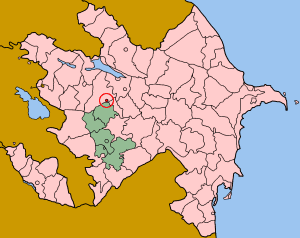Naftalan, Azerbaijan

Naftalan is a sahar (city) in Azerbaijan, surrounded by the rayon of Goranboy. It's situated on an agricultural plain near the Lesser Caucasus Mountains. The word "Naftalan", can be traced to the Greek word "naphtha", meaning pertaining to oil, and the Azerbaijani suffix "-alan", which is of the verb "to take" (and literally meaning "oil buyer").[1]
It is the center of a unique petroleum industry, with a grade of oil referred to as "Naftalan"[2]. While Naftalan crude oil is too heavy for normal export uses (unlike Azerbaijan's plentiful Caspian Sea oil), it contains about 50 percent naphthalene, a hydrocarbon that is the active ingredient in coal tar soaps, which are used to treat psoriasis.[3] As such, it is only used for medicinal purposes.[1] People using the oil generally sit in a bath and are covered in oil up to their necks (see petroleum spas below).[3]
History
Archaeological findings in the region date to the 12th century AD. The qualities of Naftalan oil has been known since early times; Marco Polo noted them.[2] The oil in the area was known to people as far as China and India, and was traded by caravans throughout countries of the Near East. Modern use of the oil has dated to the 1870s under Czarist Russia. By 1912, a German joint-stock company was founded to export and trade the oil, which was used as a treatment in the Russo-Japanese War. Research on the properties of the oil continues to be done at Azerbaijan Medical University and the Scientific Arthritis Center of Azerbaijan.
Petroleum spas
The area is home to petroleum spas (or "oil spas"), once popular vacation spots of the Soviet Union that are making a return in popularity.[3] Oil from these spas is claimed to be an effective treatment against psoriasis, arthritis and rheumatism[1]. At the height of their Soviet-era popularity, the spas in Naftalan had 75,000 visitors a year. The combination of violent ethnic conflict in nearby Nagorno-Karabakh and the end of Soviet-sponsored free trips brought the industry to its knees in the late-1980s.[3] All but one of the older spas were converted into refugee housing. The naphthalene in the oil has given in therapeutic properties, however it is not clear whether it is also a possible carcinogen. The remaining spa, the Naftalan Therapeutic Center, had 1,000-beds[1]. New spas are designed to attract tourists.[3]
References
- ^ a b c d Eldar Abbasov, Naftalan - The Miracle Oil: Azerbaijan's Therapeutic Oil, Azerbaijan International, (10.2) Summer 2002, Accessed on December 4, 2006
- ^ a b Dr. D. Y. Huseinov and Dr. A. I. Rustamov, Naftalan: The Oil that Heals, Azerbaijan International, (3.4) Winter 1995, Accessed on December 4, 2006
- ^ a b c d e Andrew E. Kramer, Bathing in Black Gold for Health and Profit in Azerbaijan, The New York Times, December 4, 2006.
